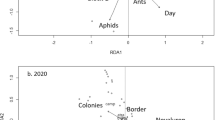Abstract
Field studies on aphid species on cabbage were conducted from 1982 to 1984. Brevicoryne brassicae L. commonly occurred on cabbage in Jos Plateau. No aphids were observed on plants transplanted in November 1982 within the first 2 weeks while those transplanted in January 1984 and February 1983 and 1984 usually had a weekly mean of more than five aphids/plant which necessitated application of aphid control treatment. High uncontrolled infestations of B. brassicae on plants aged 2–3 weeks after transplanting usually resulted in stunted growth, plant death and low yields. Decis at 7.5, 12.5 and 17.5 g a.i./ha, dichlorvos at 500, 750 and 1000 g a.i./ha, carbofuran 3 G at 1000 g a.i./ha, carbaryl 85 at 1000 g a.i./ha, and hand-washing of plants with water were used in the study. Decis, dichlorvos and carbofuran applied at 12.5, 750 and 1000 g a.i./ha respectively, were more effective in B. brassicae control. The overall cumulative mean number of B. brassicae /plant on untreated plants were 1300, 1087, 1672 and 565 for crops one to four respectively. For each crop the mean aphid number on untreated plants was significantly higher (P < 0.05) than those on treated plants. For each of the 1984 crops the yields (kg/head) from treated and untreated plants, did not differ significantly (P > 0.05), but for each of the 1982 and 1983 crops, the yields from treated and untreated plants differed significantly (P < 0.05). Plants receiving the washing technique of aphid control out-yielded untreated plants while carbofuran treated plants generally out-yielded plants receiving all other treatments.
Résumé
Lors des études sur des espèces d’Aphididae du choux entreprises entre 1982 et 1984. Brevicoryne brassicae L était l’espèce la plus frequemment associée au choux dans le Plateau Jos. Aphididae n’avait été trouvé sur les plantes transplantées dans la première quinzaine du Novembre 1982 alors que la moyenne hebdomadaire d’insectes sur les plants transplantées en Janvier 1984 et Février 1983 et 1984 était de plus de 5 aphididae/plante et avait par conséquent exigé un insecticide. Des niveaux élevés d’infestation du B. brassicae sur des plantes agées 2 à 3 semaines auparavant avaient abouti au nanisme ou à la mort du choux et à des faibles rendements. Les traitements contrôle suivants étaient utilisés lors du contrôle des aphididae: Decis à la dose respective de 7.5, 12.5 et 17.5 g de m.a./ha, dichlorvos à la dose de 500, 750 et 1000 g de m.a./ha, carbofuran 3G à 1000 g de m.a./ha, carbaryl 85 à 1000 g de m.a./ha et le lavage manuel des plantes à l’eau. Decis, dichlorvos et carbofuran à la dose respective de 12.5, 750 et 1000 g de m.a./ha étaient efficases dans le contrôle du B. brassicae. Le nombre cumulatif de B. brassicae par plante sur les plantes non traitées était respectivement de 1300, 1087, 1672 et 565 pour la première, deuxième. Troisième et quatrième campagne culturale. Pour chaque campagne, la moyenne des aphididae sur les plants non traitées était significativement plus élevée (P < 0.05) que celle des plantes traitées. Il n’y avait aucune difference significative (P > 0.05) entre le rendement (kg/tête de choux) des plantes traitées et non traitées lors de la campagne de 1984 tandis que les rendements des plantes traitées et non traitées lors des campagnes de 1982 et 1983 étaient significativement differentes (P < 0.05). Le rendement des plantes qui étaient lavées à l’eau en grise de contrôle était supérieur à celui des plantes non traitées. Le rendement des plantes traitées au carbofuran 3G était également supérieur au rendement respectif des plantes traitées avec les autres insecticides.
Similar content being viewed by others
References
Eastop V. F. (1961) A study of the aphididae (Homoptera) of West Africa. William Cloves and Sons Ltd. London and Beccles.
Gupha B. M. and Sharma J. C. (1971) Efficiency of certain insecticide control schedules against insect pests of cabbage. Madr. Agric. J. 58, 889–891.
Jones F. G. W. and Jones M. G. (1974) Pests of field crops. Edward Arnold Publ. Ltd. London.
Martin J. H. (1983) The identification of common aphid pests of tropical agriculture. Trop. Pest Manage. 29, 395–411.
Nawrocka B. (1972) Integrated control of cabbage aphid (Brevicoryne brassicae L.) on white cabbage. Ent. Rev. Washington D.C. 51, 379–387.
Nieworf (1964) Cole crops. William Cloves and Sons Ltd. London and Beccles.
Tandon P. L. and Bhalla O. P. (1977) Control of cabbage aphid with granular systemic insecticides through soil. Ind. J. Ent. 38, 181–186.
Author information
Authors and Affiliations
Rights and permissions
About this article
Cite this article
Parh, I.A., Tanyimboh, E.N. & Azubuike, C.C. Studies on the Control of the Cabbage Aphid, Brevicoryne Brassicae L., in Jos Plateau, Nigeria. Int J Trop Insect Sci 8, 373–377 (1987). https://doi.org/10.1017/S1742758400005415
Received:
Revised:
Published:
Issue Date:
DOI: https://doi.org/10.1017/S1742758400005415
Key Words
- Cabbage
- Brevicoryne brassicae L.
- aphid control
- aphid population
- treated and untreated plants
- Jos Plateau
- Nigeria




